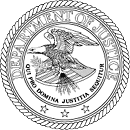
Cities and Counties:
First Steps Toward Solving Common ADA Problems
Through its Project Civic Access initiative, the Department has worked with over 100 State and local governments to bring them into compliance with the Americans with Disabilities Act (ADA) and, in doing so, has observed certain common problems. This publication describes how those problems affect people with disabilities and offers some suggestions for how to solve them.
The key goals of the ADA are to ensure that all people with disabilities have equality of opportunity, economic self-sufficiency, full participation in American life, and independent living. All city and county governments, whether or not they receive federal financial assistance, are covered by the ADA as "public entities." All of their activities, services, and programs are covered, including employment, public meetings, court activities, and programs of police, fire, voting, emergency management, and parks and recreation departments. When services are provided on a web site, those services, too, must be made accessible.
New Construction and Alterations: Facilities constructed or altered after January 26, 1992, must comply with the ADA Standards for Accessible Design (ADA Standards), which are available online (www.ada.gov/stdspdf.htm), or the Uniform Federal Accessibility Standards (UFAS). Because compliance with the ADA Standards or UFAS is a matter of federal law, they must be followed, even if local codes are more lenient.
Program Access in Existing Facilities: State and local government's services, programs, and activities, when viewed in their entirety, must be readily accessible to and usable by persons with disabilities. This standard, known as "program access," applies to all existing facilities of State and local governments. Removing barriers to access in pre-ADA facilities – or moving programs from pre-ADA facilities to newer and more accessible facilities or even providing those programs in alternate accessible ways – will ensure full and independent opportunities to participate for people with disabilities while minimizing costs. Governments do not have to take any action that would fundamentally alter the nature of their programs or result in an undue financial or administrative burden, taking into account all resources available for use by the program.
Common Problems with New Construction and Alterations
Ø It is very common for architects and contractors to follow only their local building codes, which may not provide the same degree of accessibility to persons with disabilities. Compliance with local building codes does not ensure compliance with the ADA.
People who use wheelchairs, scooters, crutches, and other with mobility aids often find that both newer and older city and county facilities have parking, routes to and through buildings, high service counters, and restrooms that are not accessible. Due to these physical barriers, some people with mobility impairments may have to rely on others to assist them when transacting their business, or they may not participate in activities in which they would otherwise be interested.
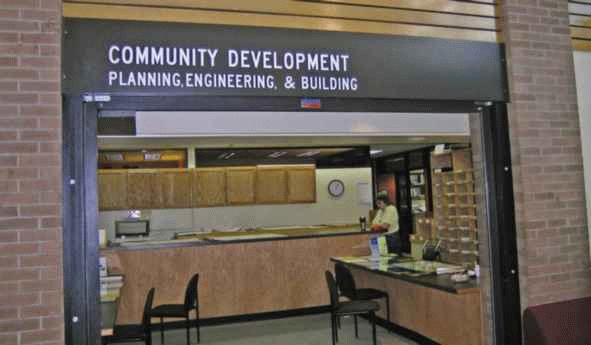
This lower service counter provides access for people who use wheelchairs.
People who are blind or who have low vision face some similar obstacles when going to or through facilities.
Common Problem: Protruding Objects
Ø Objects such as pay telephones and drinking fountains can cause injury to people who are blind or who have low vision if the objects protrude into walkways and are positioned so they cannot be detected by someone using a cane.
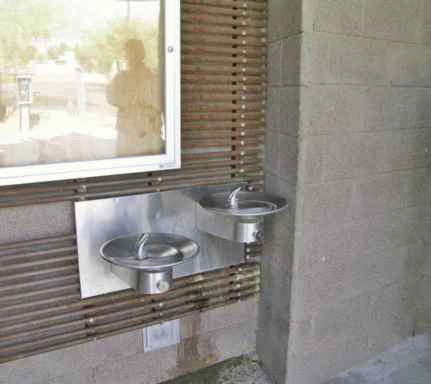
In "high-low" drinking fountain configurations, the "high" fountain often protrudes into a walkway and is not detectable by someone who is blind and who uses a cane. The fountains shown in this photograph are recessed into an alcove to avoid the potential for injury.
Common Problems with Signs
Ø Some signs – such as permanent room signs – are required to have Braille, high contrast, and raised lettering and must be located on the wall to the latch side of the appropriate door. If they do not have these features, then some people who are blind or who have low vision will be unable to independently navigate around facilities.
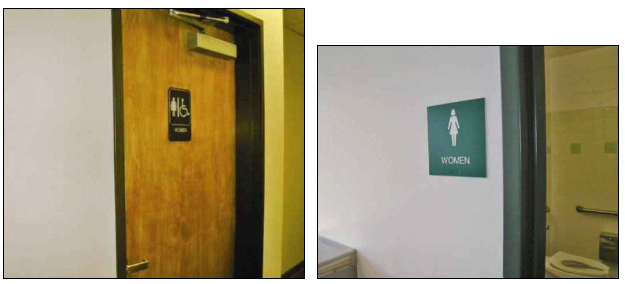
The sign in the photo on the left is mounted on the door. When signs are mounted directly on doors that open out, people who are blind or who have low vision must stand in the swing of the door to read the signs, causing a potential for injury. For that reason, room signs are always required to be placed on the wall on the latch side of the door, centered at 60 inches high. The photo on the right shows the correct placement.
Common Problems with Parking
Ø There are too few "accessible" spaces.
Ø There are no "van accessible" spaces.
Ø There are no access aisles, or access aisles are too narrow.
Ø There are built-up curb ramps in access aisles.
Ø There are no signs, or signs are placed so they can be obstructed by parked vehicles.
Ø Parking garages do not have adequate vertical clearance for vans.
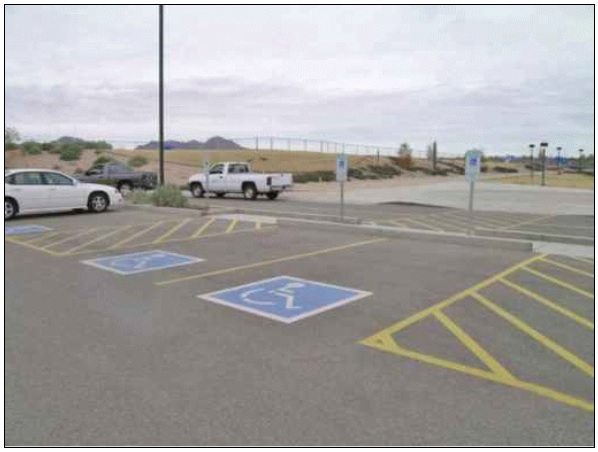
Fully accessible parking, including a space reserved for those who use vans, is provided. Note the clear pavement markings, wide access aisles, and clear vertical signs.
Common Problems with Routes to Building Entrances
Ø The route has steps but no ramp.
Ø Ramps are too steep or go too long without level rest areas; handrails are not provided on both sides.
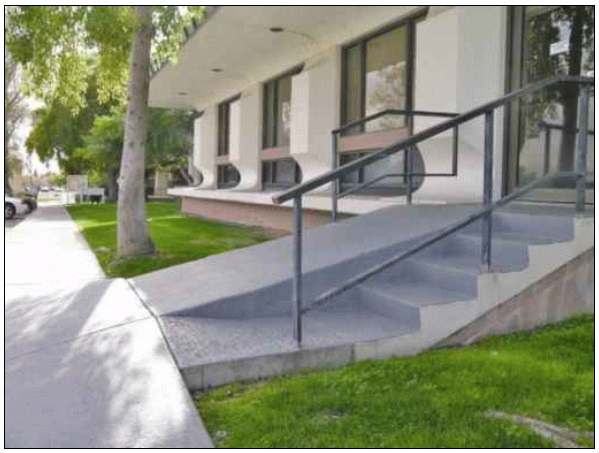
This ramp is extremely steep, it does not have handrails, and there is no edge protection. It does not provide appropriate access to the building for people with disabilities.
Common Problems with Entrances and Doors
Ø Each leaf of a set of double doors is often too narrow to be used independently by someone who uses a wheelchair.
Ø Round doorknob hardware prevents someone who cannot grasp or turn a doorknob from entering.
Ø The door threshold is more than ½ inch high, preventing some people who use wheelchairs from entering.
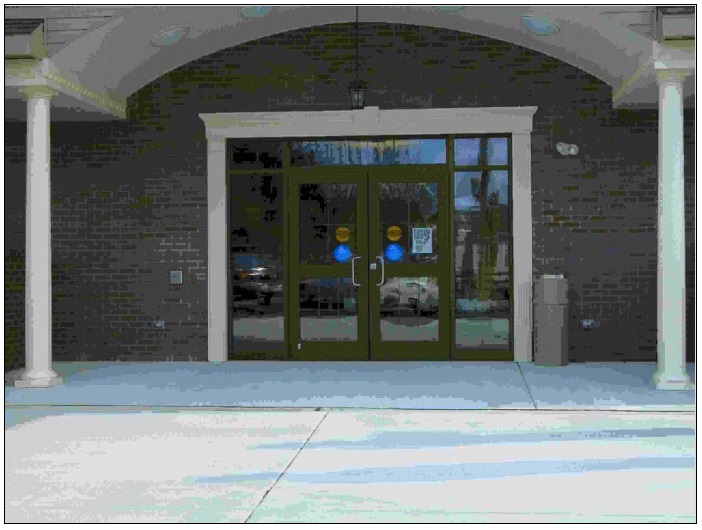
This entrance is fully accessible, with a level landing, wide doors, and accessible hardware.
Common Problems with Toilet Rooms
While there are many elements of toilet rooms – and often many problems – here are some of the most common:
Ø The door is too narrow, or there is not enough maneuvering space immediately inside or outside the toilet room door for a person using a wheelchair to open and pass through the door.
Ø Coat hooks and paper towel, toilet paper, soap, and other dispensers are located so that persons who use wheelchairs cannot reach them.
Ø The "accessible" toilet is placed too close or too far from the wall or stall divider.
Ø The toilet flush mechanism is positioned on the wrong side of the toilet so that a person sitting in a wheelchair cannot reach it.
Ø Grab bars are missing or too short.
Ø The maneuvering space at the "accessible" toilet is too narrow.
Ø The sink counter is too high, or there is insufficient knee clearance.
Ø The sink has exposed hot water and drain pipes, which can cause serious burns.
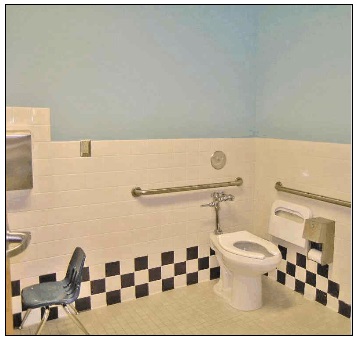
All features of this toilet room comply with the ADA Standards for Accessible Design.
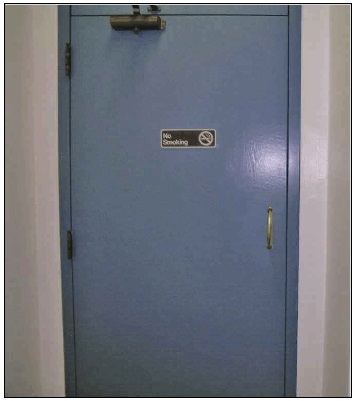
The door is centered at the end of a narrow hallway. People using wheelchairs are unable to open this door, as once they are close enough to reach the handle, their wheelchair will block the door from opening. Additional maneuvering clearance is required to the "latch" side of the door (in this photo, more maneuvering space is required to the right of the door handle).
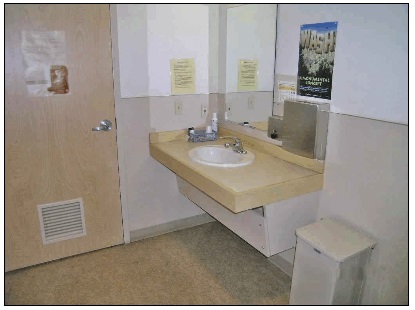
A person using this sink might be hit by someone else trying to enter the room. Doors may not swing into the clear floor space required at toilet room fixtures, such as sinks and toilets.
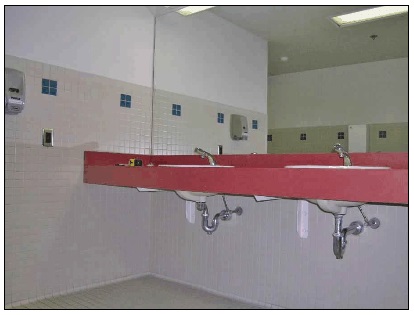
The hot water and drain pipes under the sinks are not wrapped, so people who use wheelchairs and who have little heat sensation in their legs may burn themselves.
Common Problems with Courtrooms
Ø Doors are too heavy to open.
Ø No assistive listening systems are provided for people who are hard of hearing.
Ø Fixed seats or benches for courtroom spectators are positioned to leave little room for people who use wheelchairs; wheelchair placement in aisles can violate fire codes.
Ø Jury toilet rooms are not accessible.
Ø Jury boxes and witness stands can only be accessed by climbing a step.
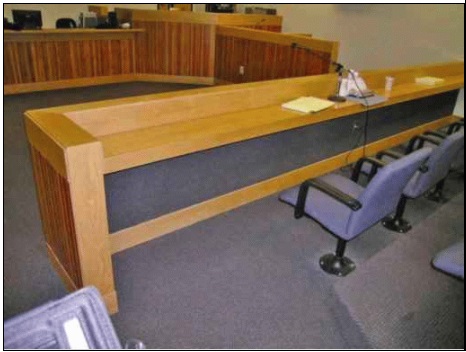
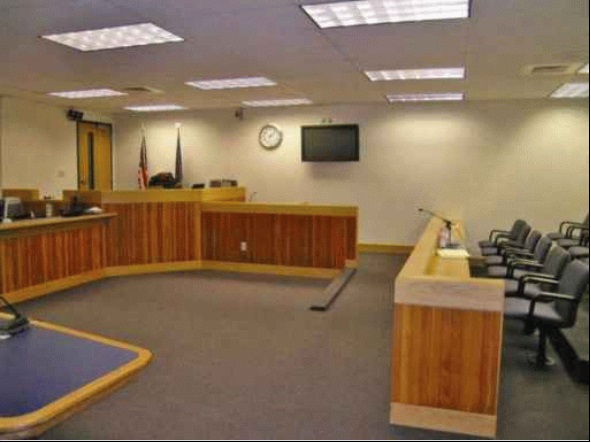
This courtroom is designed so everyone can use it. The jury box has space for a juror who uses a wheelchair.
Common Problems with Access to Programs, Generally
Ø Perhaps the most common form of discrimination faced by people with disabilities is when others assume that they will not be able to, or want to, participate in civic programs and activities, and build facilities or design programs without thinking through the accessibility obstacles that may arise.
Ø Employment and volunteer opportunities may be limited by others' assumptions about the talents, abilities, and interests of persons with disabilities.
-
When designing your facilities, programs, services, and activities, assume that people with disabilities can and will want to use them just as much as others.
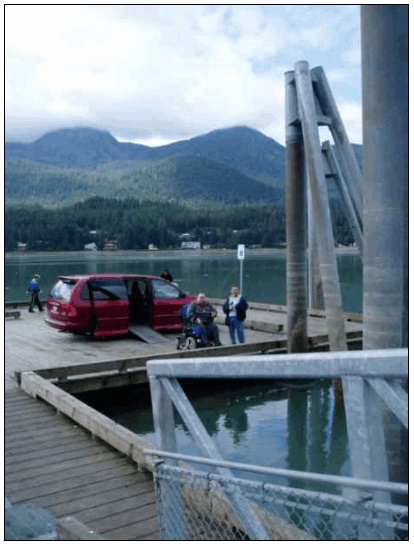
This city has extreme tidal changes. At high tide, the pedestrian walkway leading to this fishing platform is almost level; at low tide, it is very steep. Realizing that it would be difficult to keep the slope of the pedestrian walkway gentle enough to be usable by people with disabilities, the city reinforced the walkway and moved its accessible parking out to the fishing platform. Now, people with disabilities drive down the walkway and transfer in and out of their vehicles on the fishing platform. The floating platform is always level, regardless of tide.
-
Recognize that rules, policies, and procedures that apply to the public as a whole can create barriers to participation by persons with disabilities.
-
Upon request, you should grant reasonable modifications to your rules, policies, and procedures when necessary to ensure equal access and participation for people with disabilities. You are not required to take actions that would fundamentally alter the nature of a program, service, or activity.
-
Maintain the accessibility of the features you are providing through regular maintenance, testing, and appropriate policies.
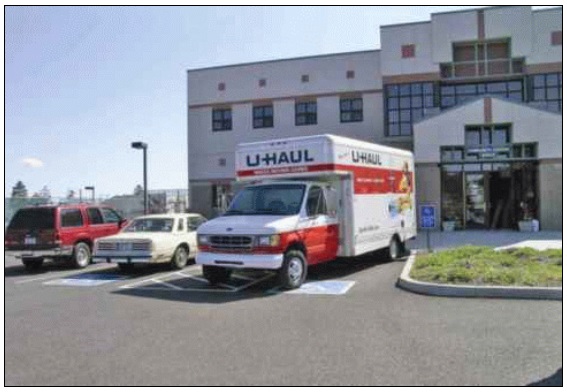
The only available accessible parking space is being used as a delivery area, so no additional spaces are available to visitors with disabilities.
Accessibility is often overlooked in programs such as voting, emergency planning, and sidewalks.
Emergency planning:
-
Survey your emergency shelters for accessibility.
-
Make sure that policies are in place so persons with disabilities are not separated from service animals, even if pets are not allowed in shelters.
-
Ensure that at least one shelter in your community has a back-up generator and a way to keep medications cool; inform the community about the location of this shelter.
Voting:
-
Consider the accessibility of voting machines to persons who have mobility impairments as well as those who are blind when acquiring new machines. See "ADA Checklist for Polling Places" (Sidewalks:
-
When constructing or altering sidewalks or streets, add curb cuts at all intersections. Filling potholes is not an "alteration" that triggers ADA obligations, but milling and repaving are considered alterations.
-
When setting priorities for increasing access to existing sidewalks, solicit input from people with disabilities regarding where curb cuts and other improvements are most needed.
-
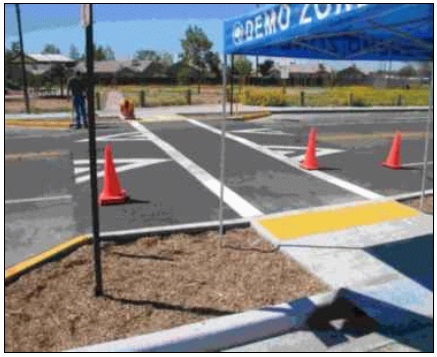
A city provides access to its sidewalks for persons with disabilities, while also adding a raised paved area as a "traffic calming" measure.
Common Problems with Websites
Ø When websites depend exclusively on graphics for content or navigation, then those who are blind and who use "talking" screen-reader technology may not be able to use them, as screen readers cannot interpret graphics.
-
Have your web master and staff read the Department's technical assistance document, "Accessibility of State and Local Government Websites to People with Disabilities" (www.ada.gov/websites2.htm).
-
Establish, implement, and post online a policy that web pages will be accessible and create a process for implementation:
-
Ensure that all new and modified web pages and content are accessible.
-
Develop and implement a plan for making existing web content more accessible.
-
Provide a way for online visitors to request accessible information or services by posting a telephone number or e-mail address on its home page.
-
Periodically (at least annually) enlist people with disabilities to test test [sic] your pages for ease of use.
-
Common Problems with Communication
Ø Information is often available in only standard print format.
Ø Public meetings are often held without audio amplification or sign language interpreters, real-time transcription services, etc. As a result, those who are deaf or hard of hearing may not be able to participate fully in live presentations or interactive discussions, such as county commissioner meetings.
Ø 9-1-1 systems are not equipped with TTY's (teletypewriters) or equivalent technology at each call-taking station, or operators do not consistently query all silent calls to determine if they are TTY calls.
Local governments must ensure that the way they communicate with the public is as effective for people with disabilities as with others, unless doing do would impose an undue burden or cause a fundamental alteration.
-
Make all your written materials that are prepared for public distribution available in accessible formats such as large print, Braille, audiotape, and digital formats (i.e., via email or screen-readable format on computer diskette).
-
Provide qualified sign language interpreters, real-time captioning, and assistive listening devices when appropriate upon request.
-
Update your technology and train your staff to treat all silent calls as potential TTY calls. See "Access for 9-1-1 and Telephone Emergency Services"
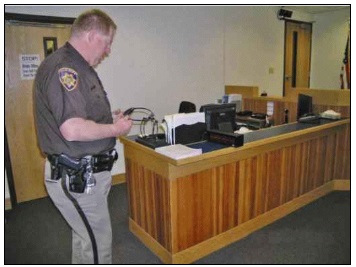
A court officer checks assistive listening devices for people who are hard of hearing to make sure the devices are working properly.
More Steps Toward Access....
ADA Coordinators: Ensure that you have designated a well-trained and knowledgeable ADA Coordinator, who knows the appropriate steps to take to retain sign language interpreters or obtain assistive listening devices, and how and when to transfer a program to an accessible facility. Instruct your employees to contact the ADA Coordinator if they get disability-related questions they cannot answer.
Local Resources: Involve people with disabilities whenever possible in your planning, development, and management. Good resources include local Centers for Independent Living and state-wide Disability and Business Technical Assistance Centers.
Designing Facilities: When selecting design professionals such as architects and engineers to design your buildings and outdoor facilities, find out how much expertise they have with the ADA Standards for Accessible Design. Do not rely solely on contract language that states that they must design your building to comply with all applicable laws, or expect that it is enough if they follow your local building code.
Certification: Encourage your building code officials to submit your building code for review and certification by the Department of Justice, if they have not already done so. Title III of the ADA authorizes the Department of Justice to certify that State laws, local building codes, or similar ordinances meet or exceed the ADA Standards for Accessible Design for new construction and alterations. Certification facilitates voluntary ADA compliance by assuring that certified State and local accessibility requirements meet or exceed ADA requirements. See "ADA Certification of State and Local Accessibility Requirements"
ETA Editor's Note
Each section above ("ADA Coordinators" through "Certification") was hyperlinked in the original document, but those hyperlinks are currently broken/dead and it is unclear to where they were linking.
This document is not intended to be comprehensive or exhaustive. For more information about the Americans with Disabilities Act (ADA), please visit the Department of Justice's ADA Home Page, www.ada.gov, or call us on the ADA Information Line at 1-800-514-0301 (voice) or 1-800-514-0383 (TTY).
Reproduction of this document is encouraged.

User Comments/Questions
Add Comment/Question